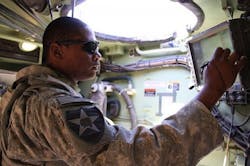ViaSat to provide additional situational-awareness transceivers for Blue Force Tracker
Officials of the Defense Information Systems Agency (DISA) at Scott Air Force Base, Ill., announced a $13.7 million contract to ViaSat on Friday for ground transceivers for the Blue Force Tracker 2 (BFT-2) program.
Blue Force Tracking describes a U.S. military GPS-enabled system that provides military forces with the locations of friendly and hostile forces: blue denotes friendly forces, and red denotes hostile forces.
ViaSat is upgrading the U.S. Army and Marine Corps Blue Force Tracking network with BFT-2 for real-time situational awareness and networking capabilities to the warfighter.
Blue Force Tracking systems consist of a computer that displays location information; a satellite terminal and satellite antenna to transmit location and other military data; a Global Positioning System receiver to determine its own position; command-and-control software to send and receive orders; and mapping software that plots the BFT device on a map.
Related: Satellite ground station equipment from ViaSat ordered for BFT-2
The BFT-2 network and transceivers improve situational awareness through fast position location information refresh rates and communications across the battlefield. The Army began fielding BFT-2 in April 2012.
The BFT-2 system offers more accuracy and capacity than the original system with real-time location updates, instant messaging, and IP-capable networking to mobile air and ground forces.
ViaSat provides the BFT-2 network with air and ground transceivers, satellite ground stations, and network control centers, as well as satellite and terrestrial communications services. The average round-trip message latency through the network is less than two seconds, ViaSat officials say.
The BFT system also can send and receive text and imagery, as well as display battlefield conditions like the locations of mine fields, battlefield obstacles, and damaged bridges. Some BFT systems also have route-planning tools.
On this contract ViaSat will do the work in Carlsbad, Calif., and should be finished by April 2018. For more information contact ViaSat online at www.viasat.com, or DISA at www.disa.mil.
Learn more: search the Aerospace & Defense Buyer's Guide for companies, new products, press releases, and videos
